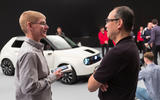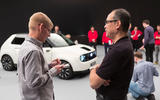The project manager of the Honda e prototype has admitted that the development team had to overcome opposition from company management before the car was confirmed for production.
The retro-styled electric-powered machine, whose styling closely resembles that of the Urban EV prototype, is a compact city car with a range of around 125 miles. Kohei Hitomi said Honda management was not initially convinced by the car's styling, small size and limited range.
Unusually, those doubts led to the development of the Urban EV concept, which was used to try to prove that a market existed for such a car. Hitomi said: "To tell you the real story, the production car came first and we created the concept out of that for a show car."
We asked Hitomi, who has spent his Honda career developing small cars, to explain in detail why the e prototype almost didn’t make production – and what convinced company bosses the EV was ripe for the roads.
What was the debate over building the e prototype?
“The biggest battle was internal, where the team decided to actually develop a small-size electric vehicle, which everybody else in the company was against. To get that through was probably the toughest battle.”
Why was that?
“Many people, including management, had the opinion that to advance market share of electric vehicles, it is essential to overcome the negatives, the drawbacks of an electric vehicle, which is driving range. To cover that, people were keen to put in a bigger battery. A bigger battery automatically means a bigger car, and a bigger car means a more expensive car. To say ‘no, we want a small car’ didn’t fit in their minds, and that was the resistance."

So how did you win?
“The positive feedback for the Urban EV concept car was certainly a breakthrough to convince internally that a small-size EV would make sense and be appreciated. I also tried to convince people that an EV is meant to be used in urban conditions, [where] the [small] size of the car is the most important aspect. That's where it makes most sense. From that perspective, the small size is the most important aspect, so that was how we tried to convince people. The concept helped the production car to get approval, and the production car helped the concept to look like what it looked like."
Read more













Join the debate
Add your comment
Europe not important?
I think recent events have already demonstrated that honda does not prioritise the European market. And it could be that in other areas, Japan and China particularly, small, relatively short range and affordable EVs are just what's needed. Either that, or for once management was right for once.
I'm slighly surprised that Honda did not develop this car with an optional small size range extender - after all the company has a lot of experience with generators and motorcycle engines which may have been easily adaptable for the purpose.
The Urban area is where
The Urban area is where electric cars are needed. That is the area where the problem lies, that is the target market.
Dunno where Rivian comes in then.
Management
They can't always be wrong.
The problem here is that bot the ( current, about to be replaced ) Zoe and the upcoming e208 are also city cars, are probably cheaper than what the Honda will cost ( the comparisons with Apple don't bode well ) and have much better range. If Renault and PSA can do it, so should Honda.
Also, re: this talk about bigger batteries necessitating a bigger car; The Honda Clarity is almost 5 meters long, and has a pityful 90 mile range. What's the excuse there?
tuga wrote:
The Zoe and e208 just look like small cars, which appeal to those who don't want their EV to stand out. The Honda is looks quite funky and will appeal as a fashion item, if successful I could see it spawning a range (with a now obligatory crossover SUV) or perhaps a subbrand, like MINI or Fiat 500. OR it could be a dead end like the VW new Beetle.